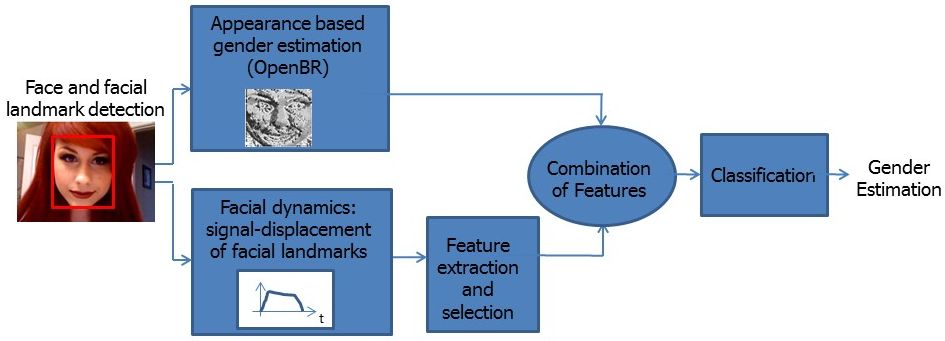Section: New Results
Hybrid Approaches for Gender estimation
Participants : Antitza Dantcheva, François Brémond, Philippe Robert.
keywords: gender estimation, soft biometrics, biometrics, visual attributes
Automated gender estimation has numerous applications including video surveillance, human computer-interaction, anonymous customized advertisement and image retrieval. Gender estimation remains a challenging task, which is inherently associated with different biometric modalities including fingerprint, face, iris, voice, body shape, gait, as well as clothing, hair, jewelry and even body temperature [31] . Recent work has sought to further the gains of single-modal approaches by combining them, resulting into hybrid cues that offer a more comprehensive gender analysis, as well as higher resilience to degradation of any of the single sources.
Can a smile reveal your gender?
In this work we propose a novel method for gender estimation, namely the use of dynamic features gleaned from smiles and show that (a) facial dynamics can be used to improve appearance-based gender-estimation, (b) that while for adults appearance features are more accurate than dynamic features, for subjects under 18 years old facial dynamics outperform appearance features. While it is known that sexual dimorphism concerning facial appearance is not pronounced in infants and teenagers, it is interesting to see that facial dynamics provide already related clues. The proposed system, fusing a state-of-the-art appearance and dynamics-based features (see Figure 9 ), improves the appearance based algorithm from 78.0% to 80.8% in video-sequences of spontaneous smiles and from 80% to 83.1% in video-sequences of posed smiles for subjects above 18 years old (see Table 4 ). These results show that smile-dynamics include pertinent and complementary information to appearance gender information.
| Age | ||||||
| Subj. amount | 48 | 95 | 60 | 49 | 72 | 33 |
| OpenBR | ||||||
| Combined Age-Groups | ||||||
| Subj. amount | 143 | 214 | ||||
| OpenBR | ||||||
| Dynamics (SVM+PCA) | ||||||
| Dynamics (AdaBoost) | ||||||
| OpenBR + Dynamics (Bagged Trees) | ||||||
While this work studies video sequences capturing frontal faces expressing human smiles, we can envision that additional dynamics, such as other facial expressions or head and body movements carry gender information as well.
Distance-based gender prediction: What works in different surveillance scenarios?
In this work we fuse features extracted from face, as well as from body silhouette towards gender estimation. Specifically, for face, a set of facial features from the OpenBR library, including histograms of local binary pattern (LBP) and scale-invariant feature transform (SIFT) are computed on a dense grid of patches. Subsequently, the histograms from each patch are projected onto a subspace generated using PCA in order to obtain a feature vector, followed by a Support Vector Machine (SVM) used for the final face-based-gender decision. Body based features include geometric and color based features, extracted from body silhouettes, obtained by background subtraction, height normalization and SVM-classification for the final body-based-gender-decision. We present experiments on images extracted from video-sequences, emphasizing on three distance-based settings: close, medium and far from the TunnelDB dataset (see Figure 10 ). As expected, while face-based gender estimation performs best in the close-distance-scenario, body-based gender estimation performs best when the full body is visible - in the far-distance-scenario (see Table 5 ). A decision-level-fusion of face and body-based features channels the benefits of both approaches into a hybrid approach, providing results that demonstrate that our hybrid approach outperforms the individual modalities for the settings medium and close.
| textbfSystem Distance | FAR | MEDIUM | CLOSE |
| FBGE | 57.14 | 79.29 | 89.29 |
| BBGE 89.3 85 79.3 | |||
| Fusion BBGE & FGBE | 82.9 | 88.6 | 95 |
While the dataset is relatively unconstrained in terms of illumination, body and face are captured facing relatively frontally towards the camera. Future work will involve less constraints also towards the pose of humans.



